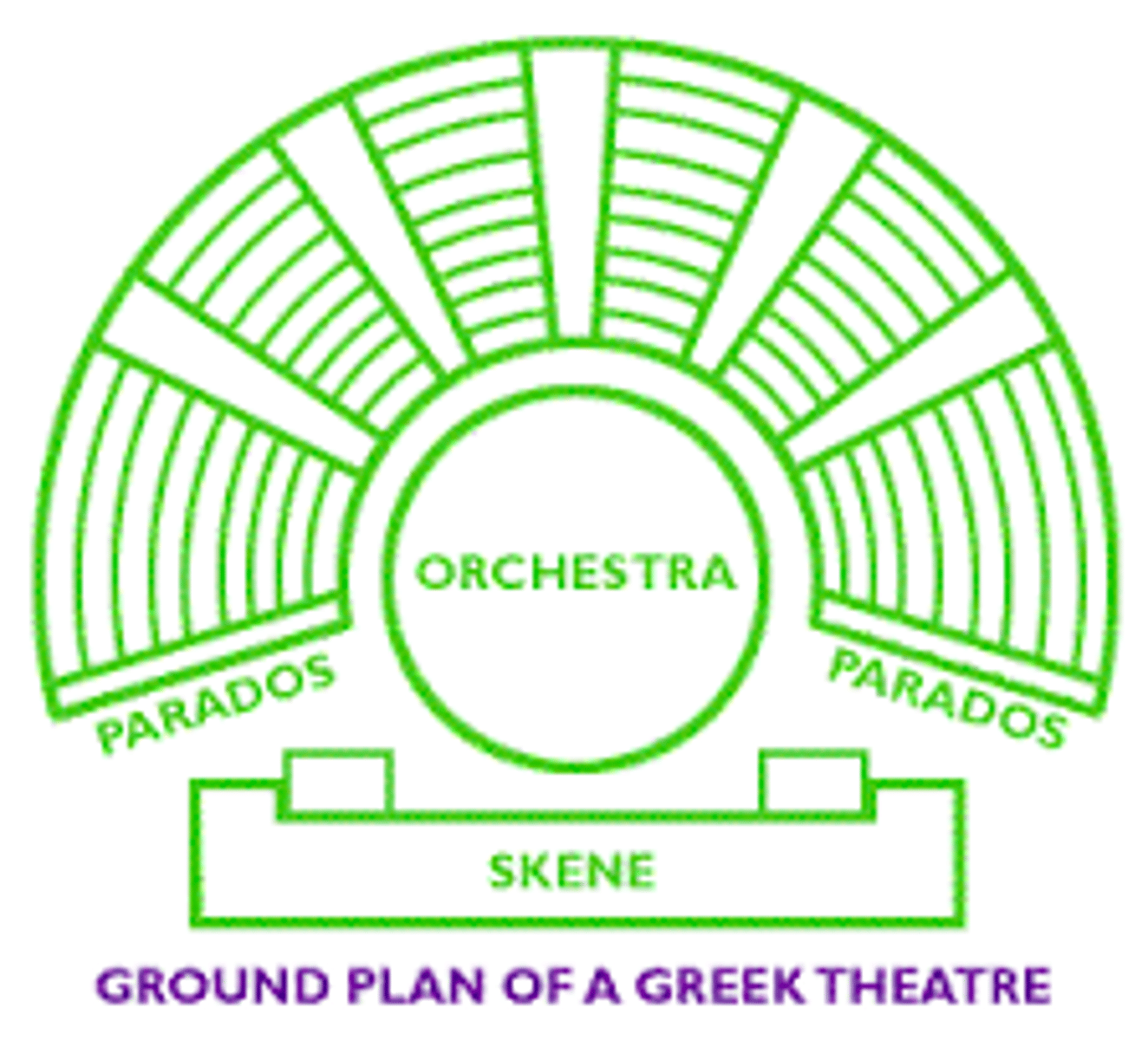Theater Studies Exam 2 Review - Key Terms and Definitions
1/83
There's no tags or description
Looks like no tags are added yet.
Name | Mastery | Learn | Test | Matching | Spaced |
|---|
No study sessions yet.
84 Terms
First recorded performance and how do we know about it?
Egyptian: Abydos Passion Play, Ikhernofret Stela
City Dionysia
Ancient Greek Religious Festival to honor the god of fertility, ecstasy, wine, and theatre
Major parts of a classical Greek amphitheater
large, outdoor theatres, usually carved into a hillside
Who are three playwrights Classical Greek?
Aeschylus (Oldest), Sophocles ( The Best), Euripides ( The Youngest)
Ludi Romani?
Festival dedicated to god Jupiter, incorporated theatre; started 240 BCE
Who are three playwrights Roman?
Plautus (Domestic Comedy), Terence (More Verbal Wit), Seneca (Tragedy, meant to be read)
mystery play
AKA cycle dramas, short plays based on Bible stories
Morality play
Medieval drama designed to teach a lesson. The characters were often allegorical and represented virtues or faults.
Hrosvitha
A German nun, female playwright.
mansion
Individual scenic units used for religious drama, in churches and outside
Draw Ancient Greek Theatre Layout

What three 3 civilizations are covered?
India, China, Japan
Natyasastra
contains plays, staging and philosophy of Sanskrit drama?
Nanxi, Chinese Opera
southern drama with Sheng: Male characters, Dan: Female characters Jing: Painted faces, demons, and gods Chou: Clowns
Noh theatre
Rigidly traditional form of Japanese drama combining music, dance, and lyrics
Bunraku
Japanese puppet theatre, popular entertainment for the merchant class, had plays about domestic life, love, and business
Kabuki
Popular 17th Cent. Japanese theatre, combines music, dance and dramatic scenes
Commedia dell'arte
an Italian Renaissance form of popular theatre that was highly improvisational, used stock characters, and masks, and was staged by traveling professional performers
Lazzi
Repeated comic stage bits or gags. Roles were for set Zanni
neoclassical ideals
- Teach moral lessons- No violence on stage- No chorus, ghosts
dramatic unities
unity of time, unity of setting, and unity of story
iambic pentameter
5 beats made of 10 syllables in unaccented-accented order
public theatre
were outdoor theatres in London
private theatre
indoor theatre spaces
Christopher Marlowe
English dramatic poet/playwright during the English Renaissance
Wrote "The Mighty Line" (Iambic pentameter)
William Shakespeare
English poet and playwright wrote 2 plays a year for 20 years
comedy of manners
Comic drama satirizes social conventions; emphasizes sophisticated atmosphere and witty dialogue; audience is aristocrats
well-made play
tightly constructed with exposition and the obligatory scene, cause-and-effect plots, secret at heart of plot, climatic endings to acts, all is resolved
sturm und drang
(storm and stress) episodic, mixes genres, bloody violence, great passions
box set
flats form 3 walls and it looks like a room
romanticism
reject artistic rules, celebrate genius and more mood and atmosphere. (The dramatic hero is an outcast seeking justice, knowledge and truth)
melodrama
drama using background music to set the mood
realism
everything onstage resembles observable, everyday life to promote a strong sense of audience recognition and identification
What are the two styles of theatre identified with modernism?
Expressionism and the Theatre of Absurd
What are two types of antirealism?
Futurism
Surrealism
Who are the Big three European playwrights who established realism?
Henrik Ibsen, August Strindberg, Anton Chekhov
unit set
a single setting that can represent a variety of locales
book musical
they had spoken parts as well as music
three descriptions of today's theatre
Global, Diverse, Eclectic
Performance art
Experimental theatre that initially incorporated elements of dance and the visual arts.
Postmodernism
a contemporary concept suggesting that artists and audiences have gone beyond the modernist movement of realism and departures from realism
3 examples of diverse theatre in USA today
African American Theatre, Latino and Latina Theatre, Asian American Theatre
Thespis
First actor to step away from the chorus and speak individually.
Chorus
Group of performers who chanted, danced, narrated, and represented community voice.
Old Comedy
Satirical Greek comedy that mocked public figures and politics.
Roman Theatre
Freestanding stone structures with semicircular orchestra, raised stage, scaena.
Liturgical Drama
Religious plays performed in Latin inside churches.
Vernacular Drama
Plays performed in everyday language outside the church.
Dance Drama
Theatre using dance, movement, and gesture to tell story.
Total Drama
Theatre combining music, dance, drama, and spectacle.
Sanskrit Drama
Early Indian drama written in Sanskrit.
Origin of Theatre (Natya Sastra)
Created by Brahma as entertainment and moral instruction for humanity.
Rasa
Emotional flavor or mood produced in the audience.
Zaju
The Yuan Dynasty Theatre had four song sequences
Zeami
Great Noh playwright, actor, and theorist.
Yugen
Deep, mysterious beauty and elegance in Noh.
Four Noh Character Types
Main actor (shite), secondary actor (waki), accompanying role (tsure), and comic character (kyogen)
Joruri
Bunraku narrative chanting accompanied by music.
Onnagata
Male actors who play female roles.
Hanamachi
Raised walkway extending through audience.
Renaissance drama was based on
Rediscovery of Greek and Roman classical models.
Intermezzi
short pieces depicting mythological tales presented between acts.
Pastoral
Plays about romance that mimic Satyr plays
Opera
Invented in Italy; drama set entirely to music.
Humanism
Renaissance belief focused on humans rather than gods
Commedia dell’arte
Improvised comedy with stock characters and masks.
Zanni
Comic servant characters in commedia.
Groove System
Early method of sliding scenery in floor grooves.
Public Theatre
Outdoor theatres open to common public (Globe).
Tiring House
Backstage building for costumes, entrances, and storage.
Sharing Plan
Actors received shares of company profits.
Comedia (Spanish)
Spanish Renaissance three-act play.
Corral
Spanish public theatre courtyard.
Moliere
Great French comedy playwright who improved Comedia Dell’arte
Two London Patented Theatres
Drury Lane and Covent Garden.
Three Restoration Theatre Characteristics
Indoor theatres, proscenium arch, moveable scenery, and actresses on stage.
Angle Perspective
Scenery painted in angled lines for depth.
Two American Realist Playwrights
Eugene O’Neill and Susan Gaspell
Theatre that rejects commercialism
non-profit
Improv Theatre
Unscripted, spontaneous performance.
Devised Theatre
Ensemble created script through rehearsal and collaboration.
Postmodernism
Mixes styles, challenges truth, borrows, questions reality.
Five Strands of Modern Theatre
Realism, antirealism, Eclecticism, Traditional forms, Globalism